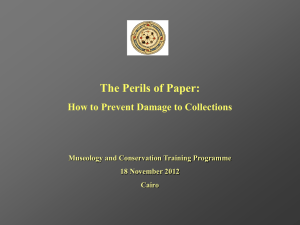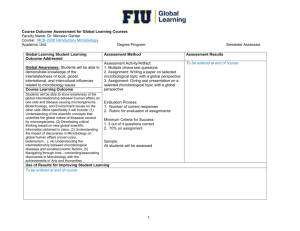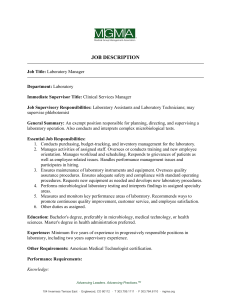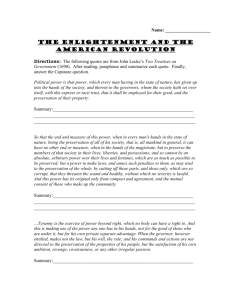Microbiological Contamination in Libraries and Archives
advertisement
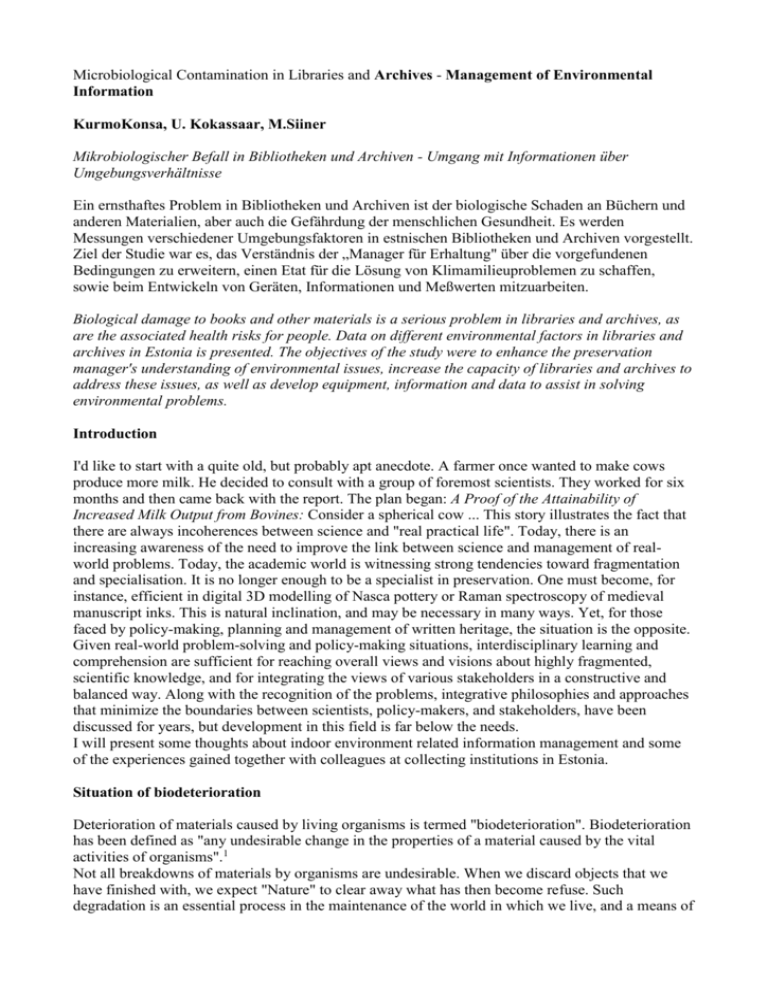
Microbiological Contamination in Libraries and Archives - Management of Environmental Information KurmoKonsa, U. Kokassaar, M.Siiner Mikrobiologischer Befall in Bibliotheken und Archiven - Umgang mit Informationen über Umgebungsverhältnisse Ein ernsthaftes Problem in Bibliotheken und Archiven ist der biologische Schaden an Büchern und anderen Materialien, aber auch die Gefährdung der menschlichen Gesundheit. Es werden Messungen verschiedener Umgebungsfaktoren in estnischen Bibliotheken und Archiven vorgestellt. Ziel der Studie war es, das Verständnis der „Manager für Erhaltung" über die vorgefundenen Bedingungen zu erweitern, einen Etat für die Lösung von Klimamilieuproblemen zu schaffen, sowie beim Entwickeln von Geräten, Informationen und Meßwerten mitzuarbeiten. Biological damage to books and other materials is a serious problem in libraries and archives, as are the associated health risks for people. Data on different environmental factors in libraries and archives in Estonia is presented. The objectives of the study were to enhance the preservation manager's understanding of environmental issues, increase the capacity of libraries and archives to address these issues, as well as develop equipment, information and data to assist in solving environmental problems. Introduction I'd like to start with a quite old, but probably apt anecdote. A farmer once wanted to make cows produce more milk. He decided to consult with a group of foremost scientists. They worked for six months and then came back with the report. The plan began: A Proof of the Attainability of Increased Milk Output from Bovines: Consider a spherical cow ... This story illustrates the fact that there are always incoherences between science and "real practical life". Today, there is an increasing awareness of the need to improve the link between science and management of realworld problems. Today, the academic world is witnessing strong tendencies toward fragmentation and specialisation. It is no longer enough to be a specialist in preservation. One must become, for instance, efficient in digital 3D modelling of Nasca pottery or Raman spectroscopy of medieval manuscript inks. This is natural inclination, and may be necessary in many ways. Yet, for those faced by policy-making, planning and management of written heritage, the situation is the opposite. Given real-world problem-solving and policy-making situations, interdisciplinary learning and comprehension are sufficient for reaching overall views and visions about highly fragmented, scientific knowledge, and for integrating the views of various stakeholders in a constructive and balanced way. Along with the recognition of the problems, integrative philosophies and approaches that minimize the boundaries between scientists, policy-makers, and stakeholders, have been discussed for years, but development in this field is far below the needs. I will present some thoughts about indoor environment related information management and some of the experiences gained together with colleagues at collecting institutions in Estonia. Situation of biodeterioration Deterioration of materials caused by living organisms is termed "biodeterioration". Biodeterioration has been defined as "any undesirable change in the properties of a material caused by the vital activities of organisms".1 Not all breakdowns of materials by organisms are undesirable. When we discard objects that we have finished with, we expect "Nature" to clear away what has then become refuse. Such degradation is an essential process in the maintenance of the world in which we live, and a means of recycling many of the essential elements contained in these materials. However, when it is an unwanted process, then it can be a really serious problem. Biodeterioration is a complex phenomenon that occurs in conjunction with other causes of decay. On the other hand, it is always very closely connected with the environmental, technological and social factors. Biodeterioration (Fig. 1) consists of a dynamic web of relationships among objects, organisms, ecological environment, technological and social factors. These parties constantly evolve and respond to each other, creating a diverse, complex, and everchanging situation. Main organisms which cause biodeterioration of heritage objects are: - microorganisms - insects - rodents Microorganisms - bacteria, actinomycetes, fungi, yeasts and algae play a very important role in the deterioration of nearly all materials and objects from books to buildings. Ecological factors, such as humidity, temperature, pH, light, oxygen etc. influence mainly organisms which cause biodeterioration. Technological and social factors which affect the objects include the materials and construction of objects, their usage and preservation activities. Managing situations of biodeterioration involves understanding and manipulating systems containing both social and natural components. Such systems are complex and dynamic. As a result, our understanding of deterioration processes of artefacts and our ability to predict how they will respond to management actions is limited. These knowledge gaps lead to uncertainty over how to manage preservation of cultural heritage best. Despite these uncertainties, preservation managers must make decisions and implement plans. It is very important to understand that there are no simple ways to deal with biodeterioration of cultural heritage. In the early 1980's, a concept of Integrated Pest Management (IPM) emerged in collecting institutions. IPM is an ecosystems approach dealing with pest problems. Components of any IPM plan include: - Monitoring and identification of pests - Inspection - Habitat modification - Good sanitation - Treatment (non-chemical or chemical) - Evaluation - Education These components are ongoing and iterative. The IPM is information intensive - it uses information on all aspects of the biodeterioration situation: - Organisms - Objects - Environment - Organization Fig. 1 Situation of biodeterioration The need for integrated and collaborative pest management supported by well-managed information is especially important in collecting institutions, where human and financial resources are often limited and the nature of heritage objects created a special circumstance. Biodeterioration management strategies should be viewed within the context of the whole preservation system of a collecting institution. The key to proper management decisions is information on biodeterioration processes; that is, an understanding is required of how these processes evolve in time and space under various impacts. Retrieval of such information relies on data to be collected, processed, analysed and evaluated. In this sense, environmental data can be considered as basic tools for decision making in preservation management. Situation of information management Managing information means how information is collected, stored, processed, interpreted and communicated. As shown in Fig. 2, information management constitutes the link between the actual biodeterioration situation and our understanding, interpretation, and assessment of the highly complex environmental processes. Therefore, data collection and information production is the most crucial activity with respect to all environmental control efforts. Fig. 2 Information management as the link between situation of biodeterioration and action Production and communication of the desired information from available data is not an easy task. The prevailing universal problem in environmental data management systems is the significant incoherence between data collection procedures and the retrieval of information required by users. Further problems stem from the lack of coherence between different disciplines involved in data management and the lack of coordination between institutions. The above considerations have indicated the need for developing integrated approaches to environmental data management. In particular, such integration is required between: - Each step of data management - Different disciplines involved in environmental data management - Different preservation surveys - Different institutions so as to develop a universally accepted solution to the problem Information Environments There are four information 'environments' within IPM. They roughly describe the totality of the information management issues to be dealt with. These four environments define different types of information as well as different uses and users of information. 1. Special information Special information includes information about organisms and objects. This is very specialised biological and technical information. Example: Water activity, rather than water content, determines the lower limits of water availability to microbial growth. Most bacteria do not grow below aw= 0,91, most moulds cease to grow below aw = 0,8. Some xerophilic fungi were reported to grow at activities of aw= 0,65, but the range of 0,700,75 are generally considered their lower limits.2 2. Prevention and eradication information Prevention and eradication information includes all information used by the conservators or other specialists to prevent the microbiological contamination and to treat objects and rooms. It includes instructions, guides, protocols, training etc. Example: Organic materials are also liable to attack from moulds or fungi, if conditions are humid, over 65% RH.3 The only way to permanently protect your collections from mold is to control the environment by keeping the temperature within 65°-70° Fahrenheit and the relative humidity within 45%-65%.4 3. Administrative and Financial Management Information Administrative and financial management information is any information collected, generated and used by institutions managers to meet their internal management requirements, including staffing information, billing information and tracking of funding sources and expenditure. Example: Staniforth (1990) has made the only attempt so far to compare the estimated costs of remedial conservation treatment with those of installing environmental control equipment. As examples for her model she uses typical (albeit approximate) costs incurred in National Trust houses. Modifying a heating system, using light control measures and purchasing monitoring equipment would cost about £ 50 000. Stanifort "guesstimates" that even these simple control measures can double the time between conservation treatments, from 50 to 100 years. Remedial conservation costs for a typical National Trust house could fall from £ 10 000 to £ 5000, and so the environmental control measures could pay for themselves in ten years.5 4. Public Information Public information includes all information connected with the use of the heritage objects, health problems of staff and visitors, communication with general public etc. Example: "The Tartu Art Museum building at Vallikraavi street is closed for visitors and is moving moulding paintings and wood sculptures from cellars to exhibition rooms."6 "Tartu University Library has been living on strict economic saving conditions for two weeks and therefore switched off the cooling systems of the repositories. This threatens the collections of the largest science library in Estonia with mould proliferation."7 Management of environmental information should take into consideration all these aspects. Management of microbiological information Providing environmental information consists of three basic activities: 1. Data collection involves insuring valid measurements of environmental parameters (temperature, relative humidity, microbiological contamination, particulate matter); assessment of buildings and rooms; collection surveys. 2. Information management, processing and delivery involve the processing of measurements of environmental parameters; dissemination of this information and making the data available to the preservation managers. 3. Communication involves interpreting and presenting information to the preservation managers in a format that is easily understood and will be useful to their day-to-day decision making relative to the environmental conditions in libraries and archives. Data collection Data collection process should begin by setting-up the information needs of management, by defining information that can be produced by data collection procedure, by designing procedures of data collection and by documentation of data collection procedures. The most critical step in developing a data collection framework is the description of information needs and data collection objectives. Data collection consists of the following steps: - Initial assessment - Visual inspection - Microbiological sampling Air sampling Surface sampling Data collection should be integrated with other preservation surveys. Preservation surveys are the various types of surveys that are carried out by collecting institutions as part of their preservation and conservation exercises. Three major preservation surveys components are: - Physical facilities (building and storage accessories) - Environment (temperature, relative humidity, etc) - Collections (conditions and history) - Organization (preservation planning and management, disaster planning, security features etc) Initial assessment The purpose of the initial assessment is to provide a general overview of the institution's situation. Background information is collected, including information on the building itself, on the collections, on the complaints of employees. Important is to conduct comprehensive analysis of the data collected during the environmental monitoring. The environmental monitoring programmes generally include measurement of basic variables (e.g. temperature, RH) and levels of lightning. In addition, assessment of pollutants (SO2, NOX, ozone, particulate matter) is also included in many of the environmental monitoring programmes. Visual Inspection The next step is a walkthrough survey conducted to search for indicators and sources of microbiological contamination, such as odours, staining, mould growth, signs of water damage, and sanitation problems. A visual inspection is the most important initial step in identifying possible contamination problems. The periodic inspections (not less than monthly) may be done by a staff member. The collected information recorded onto inspection sheets. The inspection checklist should be as concise as possible so not to burden staff with excessive paperwork. The final step in this stage is microbiological sampling. Microbiological sampling Sampling may seem to be the logical response to microbiological problems or suspicion of such problems. However, measurements may be misleading as well as expensive. They should be performed when all the investigations previously described are completed and decisions are reached on location of sampling, time of sampling, and appropriate analytic procedure. The type of information sought depends on the objectives of the monitoring sampling programme. Objectives and purposes range from detection of microbiological damages of objects to determination of the environmental microbiological state and analysis of temporal and spatial trends. Two categories of sampling can be identified: (1) periodic air or surfaces monitoring, (2) special surveys performed to assess the extent of a mould problem (e.g. a survey of microbiological contamination after disaster). A single sampling strategy cannot be established for all situations. Several factors must be taken into consideration, and several questions must be answered: - Where to sample - What to sample - When to sample - How to sample Data analysis Although obtaining microbiological sampling data is difficult, interpreting and analysing is even more challenging. Microbiological counts should not be interpreted in isolation. Observed counts are heavily influenced by many factors and have a great deal of variability, making it difficult to set limits for acceptable levels. There are no "official" standards or guidelines for fungal or bacterial bioaerosols in the air of collecting institutions. When conducting any type of air sampling, samples must also be collected outside the building of the ambient air so that a comparison between the CFU's of fungi found inside can be compared to those found outside. In general, mechanically ventilated buildings should have indoor fungal counts that are lower than those found outside. A situation should be considered unusual, when the fungal levels inside are an order of magnitude or larger than those found in the outdoor sample. Data Interpretation Analysis results by themselves are of little use, the meaning must be interpreted. In this paper, we take the position, that data collection is first and foremost a tool for managers. The principal role of it is to illuminate decision-making. Data are converted into information through data analysing and interpretation. Data interpretation helps communication between data generators (scientists) and users (managers). Because each collection with its environment is unique, standard procedures cannot be recommended. A broad understanding of all the parameters - the organisms, material of the heritage object, environment of the storage area, extent of the infestation, nature of the collection and staff and resources availability - is needed to design treatments and preventive procedures. Several strategies can be applied to control microbiological contamination in collecting institutions. Table 1 shows the strategies used at Estonian collecting institutions. Selection of the best control method for a given room's conditions is not easy and involves a complex decision that fits with resources. It is influenced by many factors such as safety, effectiveness, feasibility or budget constraints, but it is also subject of judgments to be made by more or less experienced preservation managers or other decision Tab. 1 Microbiological contamination control measures that have been used at Estonian collecting institutions makers. In turn, consistent reasoning and a method of deriving solution (decision) by person(s) involved may become critical. The Analytic Hierarchy Process (AHP) appears to be a flexible decision making tool for multicriteria problems such as selection of the best microbiological contamination control method. It enables decomposition of a problem into hierarchy and assures that both qualitative and quantitative aspects of a problem are incorporated in the evaluation process. The analytic hierarchy process (AHP) is a comprehensive, logical and structural framework, which allows improvement of the understanding of complex decisions by decomposing the problem in a hierarchical structure. The incorporation of all relevant decision criteria, and their pairwise comparison allows the decision maker to determine the trade-offs among objectives. The application of the AHP approach explicitly recognizes and incorporates the knowledge and expertise of the participants in the priority setting process by making use of their subjective judgments, a particularly important feature for decisions to be made on a poor information base. However AHP also integrates objectively measured information (e.g., yields) where this information is available. The AHP is based on three principles: 1. Decomposition of the decision problem 2. Comparative judgment of the elements, and 3. Synthesis of the priorities The first step is to structure the decision problem in a hierarchy as depicted in Figure 3. The goal of the decision, such as "Remediation of fungal contamination" is at the top Fig. 3 The hierarchical structure of the decision problem level of the hierarchy. The next level consists of the criteria relevant for this goal and at the bottom level are the alternatives for remediation to be evaluated. The second step is the comparison of the alternatives and the criteria. They are compared in pairs with respect to each element of the next higher level. For this relative comparison, the fundamental scale can be used. It allows expression of the comparisons in verbal terms, which are then translated in the corresponding numbers. As the last step, we synthesize the comparisons to get the priorities of the alternatives with respect to each criterion and the weights of each criterion with respect to the goal. The local priorities are then multiplied by the weights of the respective criterion. The results are summed up to get the overall priority of each alternative. An illustrative example A simplified example may clarify the procedure of the AHP. Let us assume that we have three alternative strategies for remediation of mould outbreak to prioritise: 1. Removal of collections 2. Dehumidification and increasing ventilation 3. Chemical treatment The criteria for the analysis of the control methods are: - Effectiveness - Efficiency - Safety - Feasibility Now we can structure the problem in a hierarchy as shown in Figure 3. The next step is the comparison of the elements in the hierarchy. We may start with the projects, which are compared with respect to each criterion. Only two projects are compared at the same time using the verbal terms of the fundamental scale. For instance, the kind of question for the criterion "effectiveness" goes: "Which is more preferred for effectiveness, the project 'removal of collections' or 'chemical treatment' - and how much more preferred is it?" The total of comparisons with respect to the criterion "effectiveness" generates a matrix as presented in Table 2. Similarly, the projects are compared regarding the remaining criteria. The local priorities (for each criterion) can be calculated by normalizing the matrix (sum of local priorities is equal to 1.00). The method allows for checking the inconsistency involved in the comparisons. The same procedure is used for the comparisons of the criteria with respect to the overall goal (Table 3). Once the comparisons are completed, the global priorities (for all the criteria) are determined (Table 4). Thus the AHP analysis gives priority to the first project (removal of collections). AHP may have major impact on the understanding by the participants of the factors, which influence the value of a project. Besides a broad agreement on the ranking of projects, the process provides profound insight in the art of complex decision-making and encourages the participants to pool their knowledge and expertise. To summarize, in this paper, we take the position that collecting information about microbiological condition at collecting institutions is first and foremost a tool for managers. That is, the principal role of this information is to illuminate decision-making. Information management that works, does so in three ways: 1. By providing an accurate assessment of the environmental conditions being managed 2. by validating that management decisions are correctly interpreted and implemented and that such decisions achieve desired consequences, and 3. By proving improved insight into biodeteriorating situation Tab. 2 Pairwise comparison with respect to the effectiveness criterion Tab. 3 Pairwise comparison of the criteria with respect to the goal Tab. 4 Priorities, weights, and the final ranking of the projects Any information management system that achieves these three objectives will almost certainly meet the additional expectations placed upon it by an interested public. In conclusion I'd like to remind the Rules of Decision Making: 1. Good decisions come from experience. 2. Experience comes from bad decisions. 1 http://www.agen.ufl.edu/~chyn/ age4660/lect/lect_25/lect_25.htm 2 W. J. Scott, Water relations of food spoilage microorganisms. Advances in Food Research, 7, 1957, pp. 83-127. 3 T. Ambrose/C. Paine, Museum Basics. ICOM 1995, p. 167. 4 Sandra Nyberg, Invasion of the Giant Mold Spore. Updated leaflet of November 1987. http://palimpsest.stanford.edu/byauth/ nyberg/spore.html 5 Suzanne Keene, Managing conservation in museums. Butterworth-Heinemann, Oxford, Boston, Johannesburg, Melbourne, New Dehli, Singapore 1996. 6 Tartu Postimees (local newspaper), May 24, 1999. 7 Eesti Päevaleht (state newspaper), July 14, 2000.
